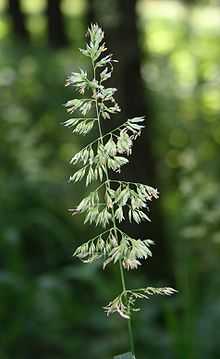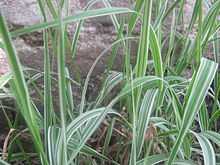Phalaris arundinacea
| Phalaris arundinacea | |
|---|---|
 | |
| Conservation status | |
| Scientific classification | |
| Kingdom: | Plantae |
| (unranked): | Angiosperms |
| (unranked): | Monocots |
| (unranked): | Commelinids |
| Order: | Poales |
| Family: | Poaceae |
| Genus: | Phalaris |
| Species: | P. arundinacea |
| Binomial name | |
| Phalaris arundinacea L. | |

Phalaris arundinacea, sometimes known as reed canarygrass, is a tall, perennial bunchgrass that commonly forms extensive single-species stands along the margins of lakes and streams and in wet open areas, with a wide distribution in Europe, Asia, northern Africa and North America.[1] Other common names for the plant include gardener's-garters in English, alpiste roseau in French, rohrglanzgras in German, kusa-yoshi in Japanese, caniço-malhado in Portuguese, and hierba cinta and pasto cinto in Spanish.[2]
Description
The stems can reach 2 meters in height.[3] The leaf blades are usually green, but may be variegated. The panicles are up to 30 centimeters long.[3] The spikelets are light green, often streaked with darker green or purple.[4] This is a perennial grass which spreads underground by its thick rhizomes.[3]
Uses
A number of cultivars of P. arundinacea have been selected for use as ornamental plants, including variegated (striped) cultivars – sometimes called ribbon grass – such as 'Castor' and 'Feesey'. The latter has a pink tinge to the leaves.[5] When grown, although drought-tolerant, it likes abundant water and can even be grown as an aquatic plant.[5]
Reed canarygrass grows well on poor soils and contaminated industrial sites, and researchers at Teesside University's Contaminated Land & Water Centre have suggested it as the ideal candidate for phytoremediation in improving soil quality and biodiversity at brownfield sites.[citation needed]
The grass can also easily be turned into bricks or pellets for burning in biomass power stations.[6] Furthermore it provides fibers which find use in pulp and papermaking processes.[7]
P. arundinacea is also planted as a hay crop or for forage.
This Species of Phalaris may also be used to extract the common compound Dimethyltryptamine. Although the concentration of the compound is very low in the species, large amounts of the grass can be refined to make the Ayahuasca brew.
Ecology
In many places, P. arundinacea is an invasive species in wetlands, particularly in disturbed areas. It has been reported as an invasive weed in floodplains, riverside meadows, and other wetland habitat types around the world. When P. arundinacea invades a wetland, it inhibits native vegetation and reduces biological diversity.[8] It alters the entire ecosystem.[9] The grass propagates by seed and rhizome, and once established, is difficult to eradicate.[10]
Chemical Properties
Some Phalaris species contain gramine, which can cause brain damage and kill animals.
Leaves of P. arundinacea contain DMT, 5-MeO-DMT and related compounds.[11] Levels of beta-Carbolines[12] and hordenine[13] have also been reported.
References
- ↑ Phalaris arundinacea. Germplasm Resources Information Network.
- ↑ Phalaris arundinacea. USDA NRCS Plant Guide.
- ↑ 3.0 3.1 3.2 Waggy, Melissa, A. 2010. Phalaris arundinacea. In: Fire Effects Information System. U.S. Department of Agriculture, Forest Service, Rocky Mountain Research Station, Fire Sciences Laboratory.
- ↑ Phalaris arundinacea. Flora of China.
- ↑ 5.0 5.1 Phalaris arundinacea var. picta 'Feesey'.
- ↑ Bond, Sam (2010-02-23). "Candidate crops for contaminated land biofuels crop considered". edie.net/crc. Retrieved 2010-04-17.
- ↑ Andersson, B. and E. Lindvall. Use of biomass from reed canary grass (Phalaris arundinacea) as raw material for production of paper pulp and fuel. internationalgrasslands.org.
- ↑ Kim, K. D., et al. (2006). Controlling Phalaris arundinacea (reed canarygrass) with live willow stakes: A density-dependent response. Ecological Engineering 26 219-27.
- ↑ Lavergne, S. and J. Molofsky. (2004). Reed canary grass (Phalaris arundinacea) as a biological model in the study of plant invasions. Critical Reviews in Plant Sciences 23(5) 415-29.
- ↑ Ecology of freshwater and estuarine wetlands By Darold P. Batzer, Rebecca R. Sharitz
- ↑ Tryptamine Carriers FAQ
- ↑ G. C. Marten, R. M. Jordan and A. W. Hovin; 1976; Biological Significance of Reed Canarygrass Alkaloids and Associated Palatability Variation to Grazing Sheep and Cattle; Agronomy Journal Vol. 68 No. 6, p. 909-914; doi:10.2134/agronj1976.00021962006800060017x
- ↑ The Alkaloids: A Review of Chemical Literature: volume 4 (Specialist Periodical Reports). The Chemical Society. 1974. p. 130. ISBN 0-85186-287-X.
|coauthors=requires|author=(help);
External links
| Wikimedia Commons has media related to Phalaris arundinacea. |
- Flora Europaea: Phalaris arundinacea
- USDA Plants Database: Phalaris arundinacea
- Jepson Manual Treatment - taxonomy and distribution within California
